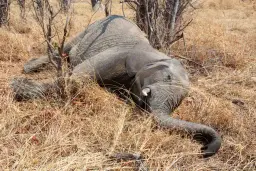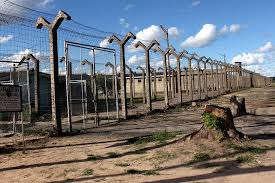Animals in Zimbabwe are suffering from starvation and dy!ng at a young age due to longer droughts. According to Tinashe Farawo, spokesperson for the Zimbabwe Parks and Wildlife Management Authority (ZIMPARKS), the animals become stuck in mud as they desperately search for water.
In Gonarezhou National Park, signs of distress can be seen, such as damaged trees from elephants searching for food and water. Farawo has received reports of similar anguish from other national parks, indicating the severity of the situation. source quotes him as saying:
It’s normal for animals to d!e, but now they are dy!ng young. They starve, they d!e. They get stuck in the mud desperately looking for water and they d!e. It’s heartbreaking.
According to Farawo, the Zimbabwe Parks and Wildlife Management Authority is still gathering data, but in Hwange, the country’s biggest park, 15 elephants and 16 buffaloes died in just one week this month. The dry periods are getting longer and harsher. In the past, Zimbabwe’s rainy season was consistent from October to March, but in recent years, it has become unpredictable, sometimes starting as late as December. He added:
Climate change is turning out to be our biggest challenge. Weather patterns have become unpredictable, so animals often have no food and water. Right now we are in November and most of the country still has no rains.
In a recent post on X (formerly Twitter), Tinashe Farawo stated that the drought has intensified conflicts between humans and wildlife in Zimbabwe as they compete for scarce water. He said:
High temperatures, poor forage, water shortages resulted in some d3aths of elephants and buffaloes. Since September, 94 elephants have d!ed in the Hwange Matetsi block. There is nothing to write home about considering the population of elephants in Hwange. There has been an increase of human-elephant conflicts in communities as animals compete for water with communities. We have recorded some cases where elephants are chasing away cattle from the water points.
Climate change is having severe impacts on Zimbabwe’s national parks and wildlife. Studies show that extreme weather events, longer dry spells, and hotter temperatures are causing the loss of plants and animals.
The Zimbabwe Parks and Wildlife Management Authority has installed solar-powered boreholes to provide water for animals, but with surface water drying up, animals are forced to travel long distances in search of food and water. The Kavango-Zambezi Transfrontier Conservation Area allows animals to migrate freely across multiple countries.
Elephants are particularly affected, facing bacterial infections and resource depletion due to overpopulation. Birds also suffer as their breeding cycles are disrupted by the consumption of trees by herbivores. Human-animal conflicts are on the rise, with communities struggling to put food on the table and animals encroaching on settlements.
Source PindulaNews









